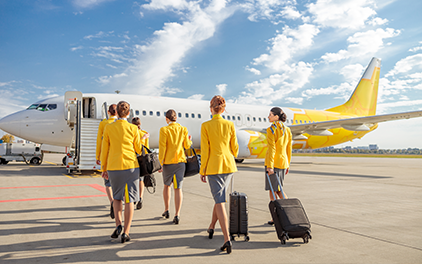An impeccable uniform and pulling their suitcases behind them. Cabin crew. Stewardesses. Air hostesses. And now more popularly known as flight attendants. Whatever name you call them, there’s more to being a flight attendant than asking, “chicken or beef”? Flight attendants are the individuals dedicated to serving you in the air and ensuring you reach your destination in one piece. It’s a much sought-after job and this month, our industry spotlight falls on flight attendants.
If you’re ready to take on the skies as a flight attendant, buckle up…you’re about to get on the flight of your life.
What is a Flight Attendant?
Flight attendants are members of an airline that are hired to ensure the flight deck (where the pilot and co-pilot sit) is secure. They serve meals, drinks, and snacks to passengers and are also tasked with ensuring the comfort and safety of passengers aboard a flight.
- Prepare cabin and crew for take-off and landing
- Demonstrate and inform passengers on safety procedures in the event of an emergency
- Inspection and verification of on-board safety equipment
- Deplaning and conducting a post flight check-up
The flight attendant is a vital member of the staff employed by every airline to ensure your safety and aid its passengers whenever needed.
Qualifications to Become a Flight Attendant
Most airlines require:
- English language skills
- Computer and mathematics skills are beneficial
- Completed your high school qualification
- Higher education qualification (in hospitality, transportation)
Airlines conduct a training programme for their recruits. Here, candidates are taught everything they need to know about being a flight attendant. Their training can include height checks, how to put out fires, deliver a baby, first aid course, and a swimming test (candidates must be able to swim). Some airlines will also take you on a mock aircraft for a walk-through and demonstration of what each flight will be and your responsibilities. These training sessions can last for several weeks in preparation for your first flight if successful.
Roles and Responsibilities of a Flight Attendant
Flight attendants will have pre-flight briefings with the pilots to discuss the flight ahead. These include cabin conditions, flight time, special requirements onboard to name a few.
- Provide medical assistance
- Check supplies and working condition of all emergency equipment
- Ensure passengers have fastened their seatbelts, bags are stowed away, and all safety measures are observed
- Provide direction to passengers, answer questions
- Provide on-board food service
- Help passengers in the event of an emergency
At the end of each flight, you will conduct a post-flight check. The senior flight attendant will write a report detailing how the flight went and if there were any incidents.
Required Skills for Flight Attendants
A flight attendant is a client-facing job. That is, you are what the customer sees, and remembers when traveling. This role requires a specific skill set to ensure you carry out all the tasks and hold up under pressure or deal with more difficult clients, without bringing the airline into bad repute.
- Patience. You need to remain calm in all situations and with all types of flyers.
- Communication skills. You must be able to speak, listen and interact with your team, pilots, and passengers clearly and confidently.
- Detail-oriented and organized. You need to keep checking and tracking where everything is.
- Interpersonal skills. You’ll be engaging with flyers from all walks of life and be able to connect with them.
- Problem-solving skills. You need to be able to assess situations and make decisive decisions, often in emergency situations or in handling an unruly passenger.
- Flexible. Varying work schedules and unexpected delays are part and parcel of the job. You need to be adaptable to the last-minute changes that come up.
There are also physical and medical requirements you need to fulfill to become a flight attendant. You need to maintain a professional appearance and have physical stamina that is required to lug baggage, young children, and other objects that require heavy lifting. Additionally:
- Specific height restrictions (to allow you to reach and close the overhead compartments)
- Be able swim
- No visible tattoos or body piercings (other than two small lower earlobe)
- Good vision (20/20) and hearing
- Clear drug test, and no criminal background
There are standard requirements across the board for cabin crew staff as set by the aviation authority. You should also note that each airline has its own additional requirements you must meet.
Career Path for Flight Attendants
Like any other career, with work experience, you can advance and reach great heights. You can work your way up from being a member of the cabin crew to being a supervisor or take on a senior cabin crew position. When you grow in seniority, you can begin overseeing schedules, and choose your routes.
You can also opt to be a corporate flight attendant. Here, you work for private clients and fly in smaller aircrafts, working on an as-needed basis. If you want to put your wings down after years in service, your first-hand experience gives you an added advantage when applying for positions with an airline. You can work in recruitment, training, passenger services, marketing, or go into a career in sales.
If you’re interested in pursuing a career as a flight attendant but aren’t sure if your skills or interests are best suited for this role, you can take our Workplace Personality Assessment. Identify your strengths, weaknesses and ascertain whether this is the career for you.








